Matador Network's Blog, page 992
October 16, 2019
Tips for camping with your dog
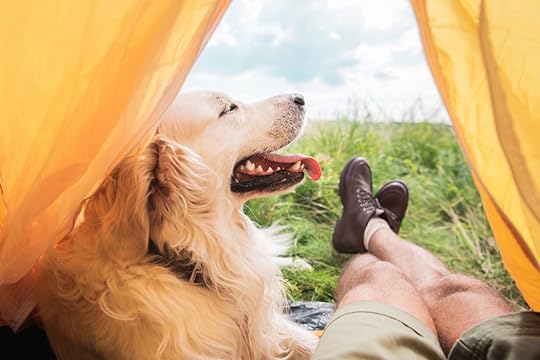
A camping trip offers the opportunity to get back to nature, appreciate the small wonders, and unplug from the hustle and bustle of daily life. But for dog owners, planning the perfect camping trip can become a nightmare. You have to find someone to look after your best friend, or you need to take your fluffy companion to a pet hotel or kennel. This can often cost more than your camping adventure itself!
But what if you could take your dog camping with you? Well, the good news is that, at some campsites, you can. But there are a few things you need to keep in mind if you want to ensure your camping trip is a good one — not only for yourself but also for your traveling pooch and the other people around you.
How to ensure your dog stays in your campsite

Photo: Iryna Kalamurza/Shutterstock
One of the trickiest parts of camping with a dog is trying to keep your pet at your campsite. With all those new smells and sights around, your dog may have a tendency to run off in search of that cute bunny rabbit or see what’s cooking at your neighbor’s site. While leashing your dog to something at your campsite might seem like the obvious option, restraining your pet in this manner is not really why you brought them along.
Instead, try putting up a small mesh portable fence around your campsite or, if you don’t like the idea of blocking the view, set up a cable run around your site and leash your dog to this. That way they can run the entire perimeter of the property and go where they like in your site but will never venture far away.
When booking your site, also see if you can book a site on a corner. That way you can face all your chairs out towards the two open sides of your site and won’t need to develop eyes in the back of your head to keep an eye on the pooch. When you first arrive at your campsite, make sure you take your dog on an orientation tour so that they can get the lay of the land and understand their temporary home. Then set up your dog’s favorite things at your campsite, such as their bed, blanket, and favorite toy so that they know exactly where home is in this foreign place. This will help your dog navigate back to you in the event that they do wander off.
How to keep your dog warm or cool in the tent
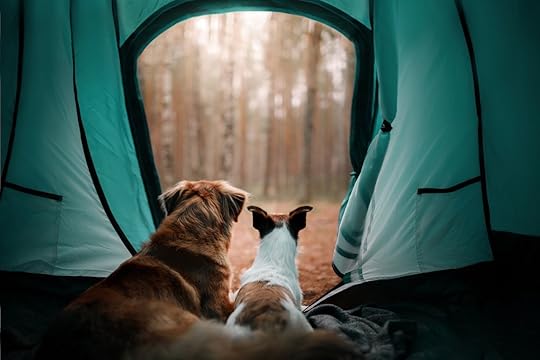
Photo: dezy/Shutterstock
While taking your dog out on a summer camping trip might seem like a good idea, tents can heat up really quickly during the day and can even become a death trap for your dog — while the reverse is true in winter. Ensure that the site you choose has sufficient shelter from the elements and try and pre-book the best spot if the campsite allows. To increase your shelter, set up a tarp or shade cloth across your site and position your tent appropriately so that it will be in the shade in the heat of the day.
Also, be sure to pack a fan or portable heater that you can use in your tent — you can get great solar-powered versions if the site has no electricity. Wet towels and a small wading bucket are also useful items to pack for that summer camping trip. Make sure to have enough water dishes available at all times and that your dog knows exactly where to find these at your campsite.
What dangers to look out for when camping

Photo: dezy/Shutterstock
While looking after your pet inside your tent and on your site is one thing, chances are you’re also going to be taking them out and about too, which brings with it a whole new host of dangers. The last thing you want is to lose your dog in a strange place, so be sure to microchip your pet and ensure their collar lists your contact details. Also, test out a whistle at home and see if they will respond to it on walks as a way to retrieve your pet.
While on walks, or even in the relative safety of your campsite, be sure to look out for other dangers your pet might not be accustomed to at home, such as snakes or scorpions, and pack a pet first-aid kit just in case. If you’re sleeping in a place with nocturnal animals, ensure your dog spends the night inside your tent and not outside alone — for their sake as well as the safety of these critters.
It is also important to look after your pet’s paws in rocky or thorny areas. Certain pet stores even sell special pet shoes if you know you’re going to be walking in the heat of the day in difficult terrain. And if you’re camping near water and your dog loves to swim, be sure to find out if it’s safe for your pet to do so and if there are any hidden dangers you need to be aware of, such as rapids further downstream, currents, or submerged rocks.
How not to annoy every other camper

Photo: Nina Lishchuk/Shutterstock
Lastly, and perhaps most importantly, when traveling with your dog, it’s important to bear in mind that most people go camping to enjoy some peace and quiet. A dog constantly barking or pestering them may be enough to get you banned from ever coming back.
To avoid annoying every other camper on site, try not to ever leave your dog alone at camp. Also, don’t be afraid to go out and introduce your dog to the other campers and dogs at the site when you arrive. If people know you and your dog, they are more likely to be tolerant should something go awry. That said, be sure to respect other campers’ space and try and place yourself and your dog away from other people as much as possible — even if that just means keeping your dog’s bed and space nestled in a quiet area of your own site.
And the number one rule: Be diligent about cleaning up after your dog as quickly as possible! 

More like this: Everything you need to know about taking your dog into the great outdoors
The post Camping with your dog is easier than you think. Here’s how to do it. appeared first on Matador Network.

Ultimate mountain bike gear list

Mountain biking is among the fastest-growing outdoor sports in the United States. Many factors have contributed to its rise. Better bike technology has brought dual-suspension, bump-absorbing bike frames into the mainstream that has literally saved the butts and guts of riders as they progress to increasingly challenging (and rocky) terrain. Increased access to backcountry trails and better maintenance of those trails has grown with the demand. And, above all else, a slew of specialized gear allows mountain bikers to take their passion with them when they hit the road. No matter your skill level or destination, the following items are essentials for a successful MTB trip.
Mountain bike trip essentials for beginners
Before you hit any backcountry trail, download a GPS-enabled trail map app. There are many available for mountain bikers but MTB Project, a trail app developed by REI, is the most comprehensive mountain bike trail guide you can have on your phone, and it’s free to download on iOS and Android. The app features mountain bike trails around the world, searchable by specific location. Riders can check into a trail, share conditions, post photos, and offer advice for important issues like where to grab a post-ride beer. The app is the ultimate trip-planning tool for riders, especially when paired with a trail map from the local bike shop.
Mountain bike shoes

Photo: Adidas
While you could head out in a pair of athletic or skate shoes, your performance on tough terrain will be far better with mountain bike shoes that either clip to or stick to your pedals. Clip-in shoes aren’t a requirement, especially for beginners and casual riders who are more likely to hop off the bike frequently or who may need to push up parts of hills. Also, clip-in shoes make it far tougher to bail off the bike should you lose control near a cliff-edge — replacing the bike is far cheaper and easier than replacing yourself. Consider sticky mountain bike shoes when you’re first starting out.
Scott makes a great pair of general-use sticky mountain bike shoes
Adidas Five Ten Freerider Pro is ideal for freeriding or Enduro
A good helmet
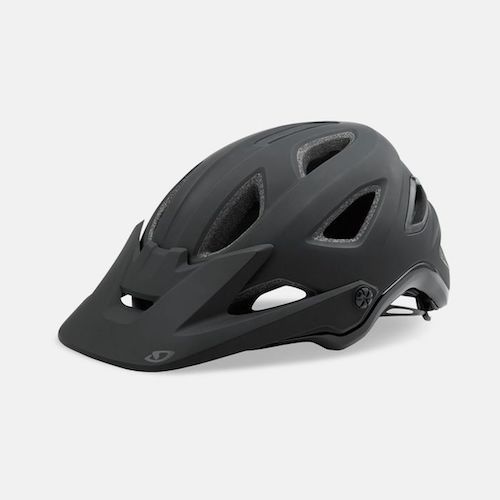
Photo: Montaro
Concussions are not the name of the game, no matter how rocky the trail is. You need a solid helmet, and fortunately in the MTB world, there’s no need to buy one of those dorky, striped, oblong road bike helmets. Mountain bike helmets are stylish, similar to the snowboard helmet. The Thousand Heritage is the perfect example and is everything you need to keep your head protected on the trail. As another highly popular option, Giro makes the Montaro helmet in both a men’s and women’s variety.
Shin guard and knee pads
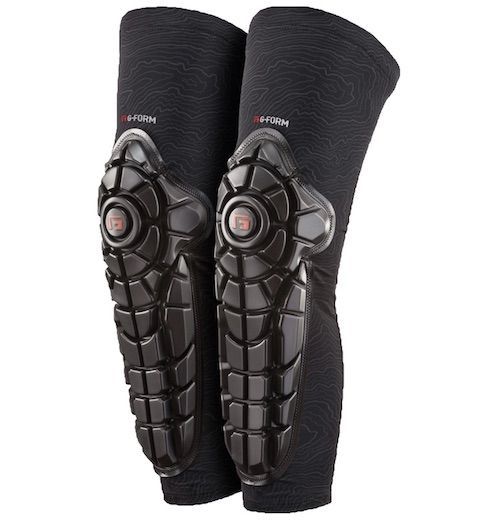
Photo: G-Form
Like everything in life, getting up to snuff in mountain biking involves making mistakes and learning from them. One mistake you’ll only make once is called the “snakebite.” This involves a sudden stop, fall, or anything else that results in your pedal conducting a sudden spin in reverse and slamming the spiked footrest into your shin. Not only is this going to be quite painful, but it’s also a near-guaranteed way to go home with an unwanted collection of small scars on your leg. You can avoid both the “snakebite” and other minor shin and knee scuffs by wearing the Elite Knee-Shin Guards from G-Form.
Backpack
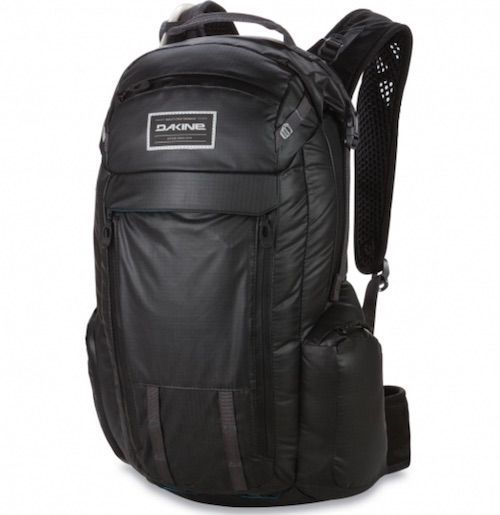
Photo: Dakin Seeker
When looking at backpacks, consider two options: a day pack and a multi-day pack. When heading out for a day on the trail or embarking on a trip where you’ll be returning to the trailhead each day with a chance to replenish basic supplies like water, opt for a small pack with a water bladder. It doesn’t need to be one specifically for mountain biking; the Classic Cycling Hydration Pack from CamelBak is perfect.
For longer or overnight excursions, a larger option like the Dakine Seeker is ideal. You want at least 12-15 liters of storage space for gear, food, and other essentials, and water bladder storage and access, which this pack provides. Its real advantage over a traditional backpacking pack, though, is that it doesn’t sacrifice the huggy, compact design of a biking daypack. The Seeker won’t get in your way and won’t spill out should you take a tumble.
What to keep in your backpack:
A stocked water bladder
A rain jacket
A first-aid kit
Protein bars and snacks
A pair of padded mountain bike gloves
A pair of mountain bike (or otherwise athletic) socks
To get to the trailhead
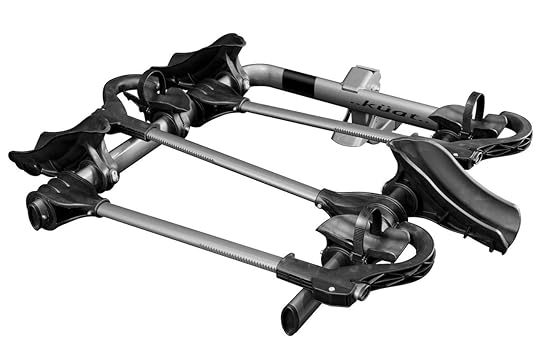
Photo: Küat Racks
Beyond your bike and the gear on your body, the most important thing you need is a way to get your bike to the trailhead. Unless you’re riding a Huffy, putting down your backseat to stuff an assembled mountain bike into the back of the vehicle is a solid way to ruin your investment, in both the bike and the car. If you drive a truck, you can load the bike into the back without inherently damaging the tires or your interior, but this doesn’t do much should you need to slam on the breaks or take a tight turn at some speed.
Put a few hundred bucks into a rack for your vehicle. The best mountain bike rack for those with a tow-hitch on their vehicle, whether for an out-of-town trip or hitting local trails, is the Küat Racks’ Transfer. It takes less than an hour to set up and mount on your vehicle, and you can easily unhitch and remove the rack for in-town travel when you’re not carrying a bike. The rack is made of steel and secures your bike at multiple points. It’s also easy to lock the bike onto the rack or vehicle, whether with the Küat’s specific lock or, in a pinch, with some general bike locks.
Plan to spend $249 for a one-bike rack and $329 for a two-bike rack. Add-on pieces to convert a one-bike rack into a double are also available, should you have the need to carry a second bike down the line. If you need a roof rack, Küat’s Mini Skinny is ideal for a one-bike setup and the Vagabond X can handle two.
What to keep in your vehicle:
A lock kit and hitch-pin
More spare tubes
Gear for inclement weather or for overnight use
To be prepared when something goes wrong
Gear to change or patch a tire tube

Photo: REI
No one should enter the backcountry on a bike without knowing a few basic repair necessities, starting with how to patch and/or change the tube in your tire should you get a flat. For this, you need five essential pieces of gear:
Steel tire levers — there are cheaper plastic ones, but spending a few extra dollars for steel prevents the risk of them snapping on you
Spare tubes, at least two, specific to your tire diameter (26, 27.5, or 29 inches)
A hand pump
A patch kit
Crankbrothers Multi-Tool with chain tool
YouTube is full of videos that will walk you through the process of changing a tube, and you should practice a couple of times before embarking on a serious ride that has the potential to leave you stuck miles from a trailhead or road. To stock yourself quickly and easily, grab the Topeak Deluxe Accessory Kit, which mounts right onto your bike and contains levers, a hand pump, multi-tool, and a pouch to keep it all in.
Gear to fix a broken chain

Photo: REI
A snapped chain can quickly lead to panic, but it doesn’t need to if you’re prepared. After stocking the items listed above, you should already have the proper chain tool. Again, YouTube is your training reference here, and a quick practice round should get you up to speed. Here’s what else to add to your arsenal:
Masterlinks (to replace the broken link), with male link on both ends
Chain lube
To fix a broken derailleur hanger

Photo: Dmitry Kalinovsky/Shutterstock
If you ride hard and frequently, a broken derailleur hanger is a consistent threat. Without being able to fix it, you might find yourself stuck, or in a best-case scenario, having to complete the rest of your ride in the gear you were in when it broke. While being stuck is worse, both situations are a major bummer. Keep a derailleur hanger specific to your bike on hand. 

More like this: Electric mountain bikes: cop-out or eco ride?
The post How to pack for a successful mountain biking trip appeared first on Matador Network.

Sardinia bans Google Maps

Winding up in the middle of nowhere and screaming obscenities at your GPS is a rite of passage for any traveler, but one town in Sardinia has had enough. According to Salvatore Corrias, the mayor of Baunei, “Too many sedans and small cars get stuck on impassable paths, sometimes even off-road vehicles too. All this because you follow the suggestions of Google Maps which, on our roads, are often misleading.” As a remedy, the town has declared war on Google Maps, posting signs along the road that read, “Do not follow the directions of Google Maps.”
Known for its rugged mountain landscapes, Baunei is a popular destination for visitors. When they follow Google Maps’ directions, however, they often end up on narrow hiking paths meant solely for pedestrians, where turning around is extremely difficult. There have been 144 rescue missions in the past two years involving tourists trapped on dangerous roads. Most recently, emergency services had to rescue a couple on vacation when their car got stuck on a mountain road.
In addition to planting signs along the road, Corrias said the town also “contacted Google to intervene, correcting the indications that give the green light to enter improbable roads,” adding that Google replied saying it would verify the issue, but nothing has been done yet.
Google did, however, tell Travel and Leisure, “We’re aware of an issue in Sardinia where Google Maps is routing some drivers down roads that can be difficult to navigate due to their terrain. We’re currently working with the local government to resolve the issue, and are investigating ways we can better alert drivers about these types of roads.” 

More like this: Why Cala Cipolla in the south of Sardinia is a beach lover’s dream
The post Town in Sardinia bans Google Maps for leading over 100 tourists astray appeared first on Matador Network.

Best black-owned restaurants in LA

Los Angeles is known for its abundance of food options but the city’s black food scene is something to revel in, too. Many of LA’s black-owned food spots have roots in the deep South. Due to migration and a lack of soul food restaurants in Southern California, many of the restaurateurs on this list set out to serve the familiar flavors of their childhoods.
While LA is not one of the country’s predominantly black cities, the West Coast hub has a variety of black-owned restaurants to dive into. If you’re headed to LA, consider planning your trip around the annual Black Restaurant Week, which celebrates the flavors of African-American, African, and Caribbean cuisines. If you’re visiting outside of this week and are in need of some tradition, community, and very good food, here are six of the best black-owned restaurants in the LA area.
1. Bludso’s Bar & Que

Photo: Post & Beam/Facebook
Born in California, but with family ties in Corsicana, Texas, chef Kevin opened Bludso’s Bar & Que in 2008 in the heart of Compton. His roots can be traced back five generations to Texas. With the popular LA restaurant and an outpost in Australia, it is no surprise that Bludso’s Bar & Que was voted the best BBQ in the state by Zagat.
The restaurant features all-day fare, from brisket and egg breakfast tacos paired with grapefruit mimosas to rib tips and pulled pork seasoned with the restaurant’s own custom dry rubs. And for the best value, order the lunch tray with brisket, chicken, ribs, cornbread, and other sides.
Where: 609 N La Brea Ave, Los Angeles, CA 90036
2. Sky’s Gourmet Tacos
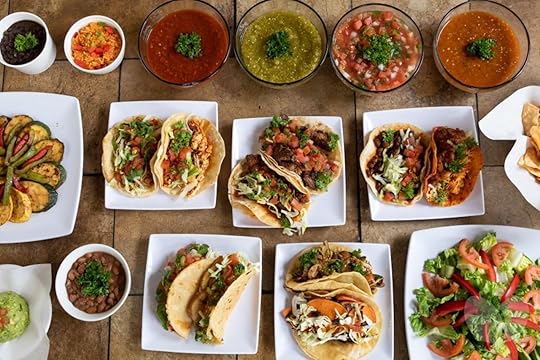
Photo: Sky’s Gourmet Tacos/Facebook
Founded by Barbara Burrell, Sky’s Gourmet Tacos opened in LA in 1992 and serves up traditional Mexican dishes with a twist. Historically, African-American and Mexican communities have lived within close proximity to one another in the city for decades. The blending of these two cultures gives Sky’s Gourmet Tacos its signature taste.
Seafood lovers should order one of the fish-based tacos, choosing between crawfish, shrimp, lobster, tilapia, and salmon tacos. For an added taste of black culture, the menu has BBQ baby-back ribs and Southern half and half (half tea, half lemonade) too. If you have a sweet tooth, Sky’s has you covered. Its extensive dessert menu was awarded the best cheesecake in LA for two years in a row by LA Weekly. A customer favorite is the caramel crunch, but if you’re feeling more adventurous, try a piece of pineapple cheesecake.
Where: 5303 W Pico Blvd, Los Angeles, CA 90019
3. Stuff I Eat
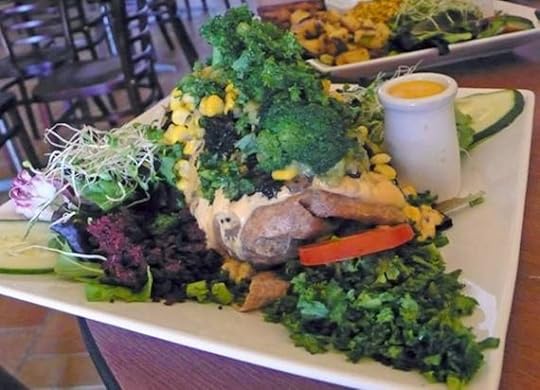
Photo: Stuff I Eat – Vegan Cuisine in Inglewood/Facebook
LA is known as the land of vegan food, and Stuff I Eat is the city’s black-owned vegan hotspot. The restaurant prides itself on using organic produce whenever possible and its dishes don’t contain any refined sugars, artificial flavors, or preservatives.
Chef B’s award-winning dishes have a large Tex-Mex influence, in addition to Southern comfort food, so you’ll find both burritos and enchiladas alongside candied yams and soul food platters. To satisfy the Mexican food cravings you’re sure to have in LA along with the desire to eat healthy, order the tofu tacos served with salsa, guacamole, and kale.
Where: 114 N Market St, Inglewood, CA 90301
4. Dulan’s On Crenshaw
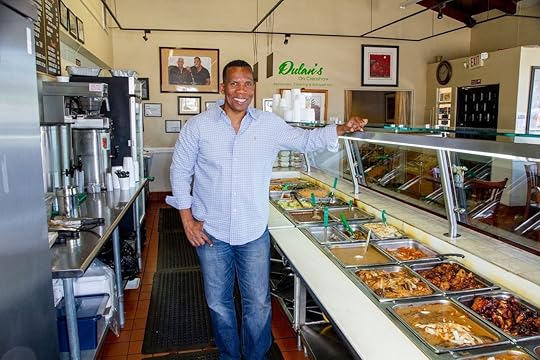
Photo: Dulan’s On Crenshaw/Facebook
In Crenshaw, Dulan’s is regarded as some of LA’s best soul food. For over 29 years, this family-run restaurant has been serving up recipes that were passed down throughout many generations. Dulan’s dishes up Southern classics like fried chicken, oxtail, yams, collard greens, and cornbread. If you’re a vegetarian, Dulan’s has tasty veggie plates too. On Sundays, check out the all-day special for one entree, two sides, dressing, a drink, and dessert large enough to feed the family for around $20. It is the place to go when you’re craving a taste of grandma’s kitchen.
Where: 4859 Crenshaw Blvd, Los Angeles, CA 90043
5. Trap Kitchen

Photo: Trap Kitchen L.A./Facebook
Trap Kitchen has been dishing out soul food with a side of black culture since 2013. Trap Kitchen is known nationwide and is frequented by celebrities and Los Angelenos as a go-to spot in the city. Chef Spank and his best friend, sous chef News, came together in spite of their ties with opposing gang communities to form the Trap Kitchen Catering Company. The duo uses cooking as a driving force away from violence in their neighborhoods. Since then, they’ve traveled across the US providing event catering and pop-up restaurant experiences in places like Atlanta, Portland, and New York City.
If you’re in LA, you can order online from Trap Kitchen. Popular dishes include the Pineapple Boat served with various meats and jasmine rice, and the Cajun alfredo pasta. The restaurateurs released a cookbook in 2017, Bangin’ Recipes From Compton, in case you want to enjoy their best recipes long after you’ve left LA.
Where: Order online
6. Post & Beam
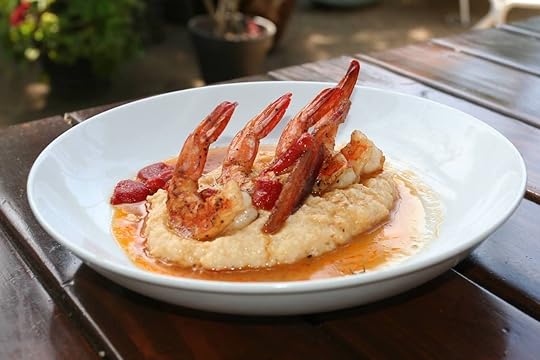
Photo: Post & Beam/Facebook
Brunch takes on a whole new meaning at Post & Beam in LA’s Baldwin Hills neighborhood. Founding owner and veteran restaurateur Brad Johnson created Post & Beam with the intention of running a black-owned and operated restaurant. From the head chef to the front of house team, the staff here are predominantly African-American. Its comfort food offerings draw in crowds of locals every weekend who rave about the ambiance, exceptional service, and tasty dishes.
Brunch lovers should try the pecan pie French toast topped with bourbon caramel or the braised oxtail hash served with country potatoes. If you’re a plant-based foodie, try ordering the vegan crab cakes or the impossible burger with avocado and balsamic onions. During lunch, the jerked catfish with dirty rice is a standout choice. The open kitchen and herb garden patio lined with orange trees was designed to make diners feel at home, while the curated playlist and live jazz keep this spot buzzing.
Where: 3767 Santa Rosalia Dr, Los Angeles, CA 90008 

More like this: Slutty Vegan is Atlanta’s hottest vegan restaurant for all the right reasons
The post The best black-owned restaurants in Los Angeles appeared first on Matador Network.

8 outdoor adventures in Japan

Picture Japan and you probably picture the urban, the bright lights and busy streets of Tokyo, perhaps. But most of the country couldn’t exist further from this image — 95% of the land is undeveloped, an untamed archipelago of active volcanoes, dense forests, and snow-covered mountains. A trip from tip to tip takes you from tropical beaches to powdery ski resorts, and volcanic jigokudani, or hell valleys, smoke and steam along the way. Naturally, everyday life here is entwined with Mother Earth, and whether you like to dive, hike, or paddleboard, it’s easy to develop a lengthy list of dream adventures in Japan.
But with a country as expansive as this — nearly 2,000 miles from top to bottom — dream lists can often remain just that. Luckily, ANA (All Nippon Airways) flies to some 50 airports in Japan, meaning adventurous travelers aren’t confined to major metropolises. As well as taking you to your destination in style and comfort, ANA even gives you a heads up about what you might see from the airplane window during your flight. Bird’s-eye views of the Japanese Alps, the golden coastlines of Okinawa, or Mt. Fuji rising above the clouds just might inspire your next adventure.
In that same vein, here are eight ideas to get you dreaming of an epic outdoor adventure in Japan.
1. Floating through Takachiho Gorge
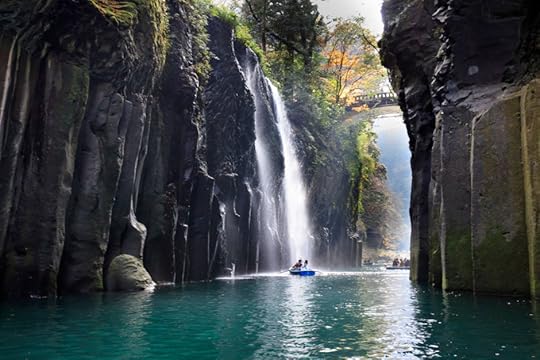
Photo: Shutterstock/Norimoto
Fly to: Miyazaki
Gliding across the emerald waters of Takachiho Gorge in Miyazaki, it’s easy to imagine you’ve stumbled on the inspiration for most of Hollywood’s fairy-tale, CGI-animated landscapes. Basalt columns said to be reminiscent of dragon-scaled skin stand tall, creating an Avatar-like scene — complete with the requisite gushing waterfall spilling into the calm waters of the Gokase River below.
Rowboat rentals are available to anyone who wants to admire the 55-foot Minainotaki waterfall from below, while the nearby walking trail ends at the gates of the Takachiho Shrine.
2. Climbing Mt. Fuji
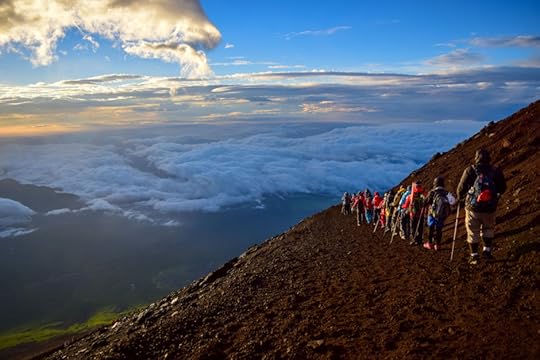
Photo: Shutterstock/Nackoper
Fly to: Tokyo
Summitting Mt. Fuji is quite possibly the pinnacle of Japan’s outdoor experiences. Challenging climbers with rocky paths, substantial elevation, and fickle weather, the 12,388-foot landmark provides an opportunity to test not only hiking prowess but also true climber camaraderie. Rest huts, much-needed benches, and even occasional queues offer opportunities to meet fellow adventurers.
Climbers are greeted by the Okumiya Shrine at the summit and can take in the views before beginning their descent. If timing allows, try to get to the top for sunrise.
3. Swimming with manta rays off Ishigaki

Photo: Shutterstock/Martin Voeller
Fly to: Ishigaki Island
The Yaeyama Islands, the tropical isles of Japan south of Okinawa, are home to abundant sea life and attract divers, snorkelers, and swimmers to their underwater wonder world. As well as traditional scuba-diving opportunities, Ishigaki — the main island in this group — is known for the sweeping shadows of its reef manta rays.
With only five boats at a time permitted in the most popular spots, divers can swim alongside the local inhabitants without fear of crowding them. A rare opportunity to see rays up close, it’s an unforgettable experience in a beautiful location.
4. Summitting Mt. Rishiri
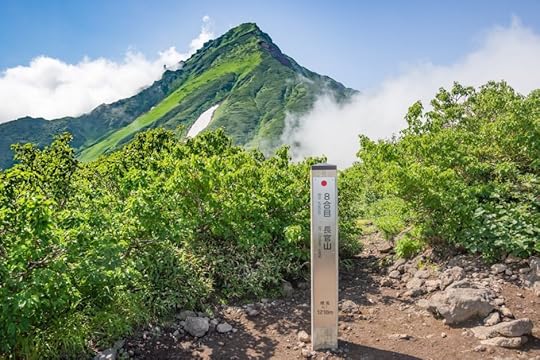
Photo: Shutterstock/Rayints
Fly to: Rishiri Island
Nicknamed “Rishiri Fuji” thanks to its resemblance to Japan’s most iconic peak, the summit of Mt. Rishiri takes a full day to reach. Located on a remote island 12.5 miles from the mainland of Hokkaido, the mountain is not quite half Fuji’s size, at just over 5,500 feet tall.
From June to August alpine flowers blanket the island, adding a spring-like feel to this coldest region of Japan. For those preferring pedals over boots, there’s a dedicated cycling road tracing nearly 38 miles of the island’s outskirts, taking you past quiet fishing villages and quieter hot springs, all with the view of Mt. Rishiri looming in the distance.
5. Ice fishing and camping in Hokkaido
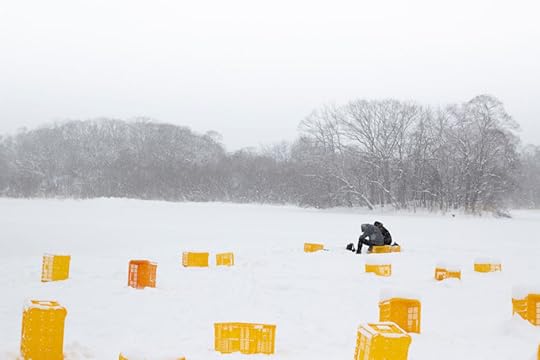
Photo: Shutterstock/Anochastock
Fly to: Sapporo
Requiring patience, warm clothing, and a love of snowy landscapes, ice fishing is a seasonal highlight on the northern island of Hokkaido. Known for snow festivals and skiing, the island also has rivers that freeze over for almost half the year, allowing locals to turn to a relaxing pastime.
Dipping bait through carefully drilled holes in the frozen surface, the dedicated can catch enough small wakasagi (smelt) for a simple grilled lunch — probably the freshest meal you can get in a country renowned for the freshness of its cuisine. The Barato River is only half an hour from Sapporo and a great place to start, with colorful ice fishing tents and crates adorning the water’s solid surface in winter.
6. Hiking Mt. Misen
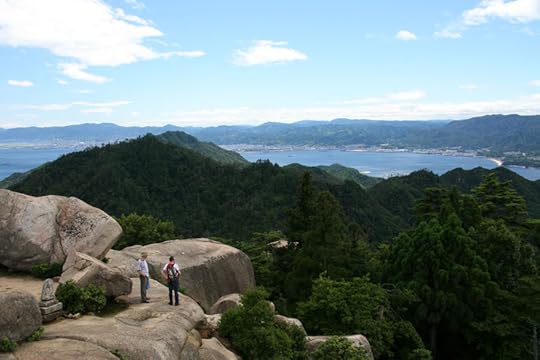
Photo: Shutterstock/Sam DCruz
Fly to: Hiroshima
Rising above the spiritual island of Miyajima in Hiroshima, Mt. Misen rewards hikers with stunning views across the Seto Inland Sea. Included in the vista is the famous floating torii gate of Itsukushima Shrine, serene at the water’s edge below.
With an elevation of 1,600 feet (straight out of the sea), the mountain has three trails covered with both temples and deer — as well as the occasional monkey. Mt. Misen is awash with cherry blossoms in spring and golden leaves in autumn (especially on the steep Momijidani trail), seasonal subtleties warranting return visits.
7. Paddleboarding and canyoning in Okutama
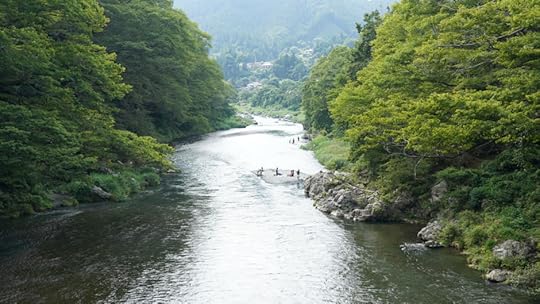
Photo: Shutterstock/Stossi Mammutto
Fly to: Tokyo
Technically in Tokyo but a far cry (and a two-hour train ride) from the neon streets of the capital, Okutama is a western suburb and forest town where the list of things to do reads more like that of a national park. Here you climb mountains, navigate lakes and rivers, and wander through caves.
The clear Tamagawa River is lined with rapids and sleek limestone, combining to create some epic canyoning options. For beginners seeking a thrill, zip lines will guide you through rushing currents and into pools, while the more experienced can rappel down steep walls, launch off higher jumps, and work the ropes. Alternatively, paddleboards and kayaks offer an opportunity to take in the scenery at a more relaxed pace. The river opens up in the Mitake-Keikoku Valley for some pretty epic views.
8. Exploring Mt. Koya and the Kumano Kodo Trail
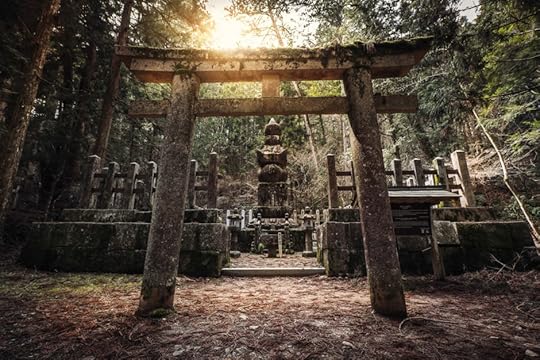
Photo: Shutterstock/Sabino Parente
Fly to: Osaka
Mist-covered and serene, the town of Koya — sitting at the foot of the mountain of the same name — is a prime stopping point on the sacred Kumano Kodo pilgrimage route. Snaking across the Kii Peninsula, this network of trails connects the Kumano Sanzan, three powerful shrines that are among the most important in the country.
Over the centuries pilgrims have crossed the mountains by foot, enduring challenging conditions to deepen their faith, and many continue to do so today. Winding through ancient forests, the journey is rewarding regardless of your beliefs and the perfect opportunity to experience the Japanese art of shinrin-yoku, or forest bathing. Because in Japan, epic adventures come in all speeds. 
The post 8 epic outdoor adventures in Japan appeared first on Matador Network.

October 15, 2019
What is Hawaiian agricole rum
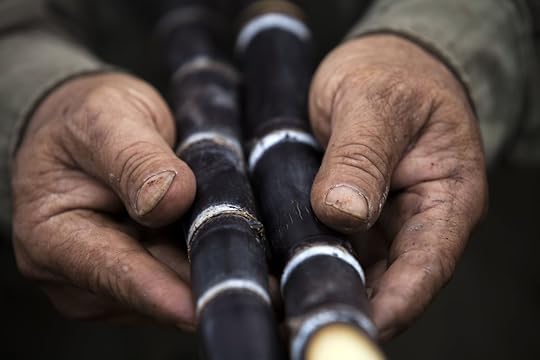
On a hillside in Kunia, Oahu, sits a squat rectangular building with the words Kō Hana Rum stenciled on the front. It looks unremarkable from the outside. The inside is sparse too, populated with little more than a simple bar for tastings and a couple racks selling t-shirts. From first glance, you’d hardly know the founder spent years behind the scenes, searching out and cultivating heirloom sugarcane, much of which was lost during Hawaii’s sugar boom. But there is much more Kō Hana Rum than appearances suggest.
Just behind that green building, a steep dirt road, which passes through the small aquaponic farm next door, will lead you into the hills above the distillery. Along the path, the grass grows taller than an adult man. The longer you walk, the more it feels like the rest of the world is slipping away, until you find yourself standing among the curved stalks of the distillery’s sugarcane. Arched black bodies of cane spiders scurry among the roots, and the rolling green mountains capped by grey clouds are just visible in the distance.
Sugarcane can grow in wide open fields and near rivers, and it can be found everywhere from Indonesia to Jamaica. Kō Hana’s sugarcane farm rests at the base of Kunia’s nearby mountain range. A muddy path cuts through the densely packed rows of cane. The tall, dusty brick red and beige stalks obscure your view of the world outside the farm. Bouquets of dark purple and emerald green leaves burst from the top of stalks. All that’s visible for miles is sugarcane, and above there is nothing but blue sky. The farm is a magical, peaceful place, especially on an overcast day when the clouds hang low in the sky, and there’s no sound traveling up from the nearby road.
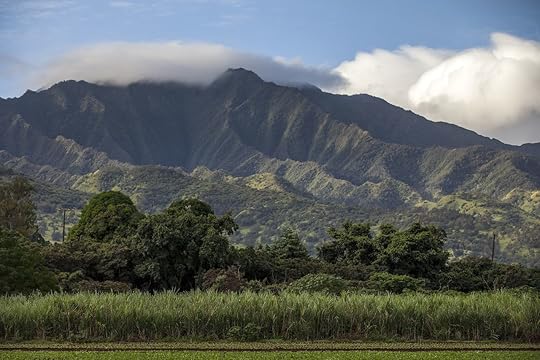
Photo: Kō Hana Distillers
Sugarcane has been growing in Hawaii for a long time — at least 1,000 years — and its uses and purpose have grown and changed along with the islands. Sugarcane has seen every phase of Hawaii’s history.
Sugarcane, or ko in Hawaiian, is one of 27 canoe plants (others include taro, yam, and kava) that early Polynesian settlers brought to the islands between 400 and 500 AD. Sugarcane became a tool of Hawaiian spiritual practice, often invoked during prayers to the gods of sailing and canoe building. It was also used to coax lost lovers back home, sweeten the taste of bitter medicine and heal wounds, and as thatching for homes.
In 1835, Ladd and Company, founded by a group of friends from New England, opened the first successful sugarcane plantation (another operation tried in 1825 but closed two years later) in Koloa, Kauai. Ladd and Company’s arrival in Hawaii marked the beginning of a period of economic prosperity (mostly for the European and American businessmen who settled there), tumult, and transition.
Though the United States acknowledged Hawaii’s independence in 1842, European and American merchants swooped in to open ranches and farms that would exploit the island’s fertile land. By the late 1840s, the islands were exporting silk, beef, coffee, and molasses. In 1843, the British unsuccessfully claimed Hawaii as its own during an occupation that lasted just five months. Meanwhile, missionaries worked tirelessly to convert the indigenous population to Catholicism, and the islands began printing paper money and operating a mail service. Fifty-eight years after Ladd and Company opened its plantation, the United States overthrew the Hawaiian monarchy, and five years later the islands became a US territory.
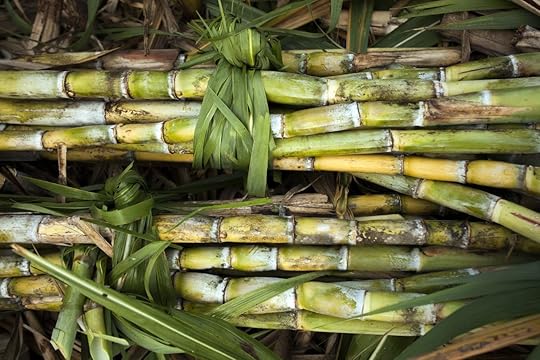
Photo: Kō Hana Distillers
Sugarcane plantations transformed the crop from a cultural pillar for the island’s indigenous people to an economic windfall for the island’s colonizers. The sugar industry exploded, and Hawaii’s economy quickly became inseparable from sugarcane. Plantations opened throughout the islands — even Kō Hana occupies a former Dole plantation — shipping most of its product to the mainland United States. Some 200 years later, that part of sugarcane’s history was wiped away, too — the last sugar mill, in Maui, closed in 2016. Today, sugar isn’t produced from sugarcane anywhere in Hawaii, and sugarcane itself is rarely grown on local farms.
Robert Dawson is helping change that. In 2008, Dawson relocated from the Southwest to Hawaii, where he wanted to raise his son. Dawson worked in tech and had no experience in distilling or farming. But when he arrived on Oahu, sugarcane caught his attention. After reading a book about Hawaii’s native plant life by Dr. Noa Lincoln, a professor of indigenious crops and traditional farming methods at the University of Hawai‘i at Mānoa, he didn’t need any more encouragement: Dawson decided he would open his own “grass to glass” distillery for agricole rum produced with sugarcane rather than the molasses most rum producers use. He also decided he would honor Hawaii by growing only heirloom sugarcane on an adjacent farm. Dawson had found his calling.
Dr. Lincoln — who would eventually analyze the genetics of the cane Dawson found in the wild, and help educate Kō Hana staff on the significance of sugarcane in Hawaiian culture — calls heirloom sugarcane “kupuna crops,” or crops developed by Hawaii’s elders, “prior to European arrival and the development of the sugarcane plantations.” Lincoln adds that it is “likely that most varieties were developed here in Hawaii from the original varieties introduced by the Polynesian wayfinders.”
Finding heirloom sugarcane proved difficult. Hawaii’s sugar industry wreaked havoc on heirloom strains of sugarcane. Sugar plantations instituted breeding programs, which developed sweeter, disease- and pest-resistant varieties of sugarcane. The farms also practiced monocropping, planting the same modified variety of sugarcane on their land year after year. These practices demolished the islands’ natural biodiversity. To find heirloom sugarcane, Dawson had to look in the wild.
Dawson, alongside his business partner, Jason Brand, decided to go straight to the people. He posted notices on Craigslist, asking anyone with wild sugarcane growing in their backyards if he could take cuttings. He gathered stories from locals about where they had seen sugarcane growing in vacant lots and on the side of the road.
Dawson marched through botanical gardens, hunting down random stalks and asking the botanists tending the plants if he could take pieces home. He also began researching the lore surrounding sugarcane and found that it’s at the center of stories connecting the land and the sea, that the heirloom varieties shared names with shark gods and fish — history that nearly disappeared after the sugar plantations moved in.
After three years of searching, Dawson managed to gather around 91 sugarcane plants with different names and cultural significance, some with similar characteristics. Kō Hana Rum now grows 36 genetically unique varieties of sugarcane, but there are thousands of varieties still left to be discovered all over the pacific.
“Of the 36 varieties that Robert has, a number of them are not Hawaiian varieties, but are heirloom varieties from elsewhere in the Pacific,” Lincoln explains. “He likely has about 25 that we feel confident are kupuna [heirloom] varieties. My own collection is about 80 canes, maybe 35 of which I feel confident are kupuna varieties.”
The farm, with Dawson’s freshly planted sugarcane, opened for business in 2009. Dawson spent the next four years learning to farm and distill as the sugarcane grew up around him. Manulele Distillers (the company’s original title, named for the first strain of sugarcane Dawson found) where Kō Hana Rum is produced debuted its first bottle of rum in 2014.

Photo: Kō Hana Distillers
Hawaii doesn’t manufacture glass, so the distillery needs to ship in bottles, but Dawson did ultimately achieve his original goal: Everything that goes into Kō Hana Rum is produced on the adjoining farm.
“We are a vertically integrated system — grass to glass, as we like to say,” says Kyle Reutner, Kō Hana Rum’s brand manager. “That’s frankly unheard of. [Other distilleries] still need to source something from someone else.”
According to Reutner, 97 percent of rum distillers produce their spirits using molasses while only about three percent use sugarcane — and that’s worldwide (an entirely different spirit, called cachaça, is distilled exclusively from fermented sugarcane in Brazil). Distilling rum from sugarcane is more difficult for a couple reasons: Once the sugarcane is harvested and the cane juice pressed, it needs to be fermented and distilled immediately (or refrigerated, which can get expensive) so that it doesn’t ferment on its own and turn sour. That’s why it’s essential for Kō Hana to be vertically integrated: The sugarcane is harvested in essentially the same place where its juice is distilled.
Secondly, sugarcane is a seasonal crop in most places (Hawaii, where it grows all year, is an exception). So if you’re distilling rum with sugarcane exclusively, you’d have to shut down your operation for part of the year. Molasses — a byproduct of the sugar refining process — on the other hand, is available anytime (most distillers buy it from sugar refineries) and stays fresh for years.
“If you are making an agricole rum, it’s for cultural reasons or flavor reasons,” says Richard Foss, author of the book Rum: A Global History. “Because making agricole rum is more expensive and the process is going to take more work and more of a time crunch on your distillery.”

Photo: Kō Hana Distillers
Agricole rum and molasses-based rums are so distinct that Foss thinks they shouldn’t even be in the same category. The dominant flavors in the latter are sweet caramel and vanilla, while the former has more herbal, grassy notes. And agricole rum has a more palpable terroir, informed by the soil where sugarcane is grown, whether it be at the mouth of a river in Venezuela or at the base of a volcano in Hawaii.
Kō Hana is interested not just in sugarcane as a cultural artifact but also in the more elegant, complex flavors it brings out in rum. And if that wasn’t already enough, the sugarcane farm also supports Hawaiian agriculture at large.
“Hawaii needs to grow more farmers,” Reutner explains. “We need sustainable jobs that the next generation is going to want to do. If nothing else, if you don’t like our rum, at least we’re providing an outlet for land use that’s not just hotels. It’s something a little more honest and of the earth.”
The act of growing heirloom sugarcane, a form of agriculture which Reutner says hasn’t existed in a “major capacity since Hawaii had a king” alone feels radical. But respect for the sugarcane, its history, the land where it’s grown, and the people who harvest it, are also significant aspects of Manulele’s business model.
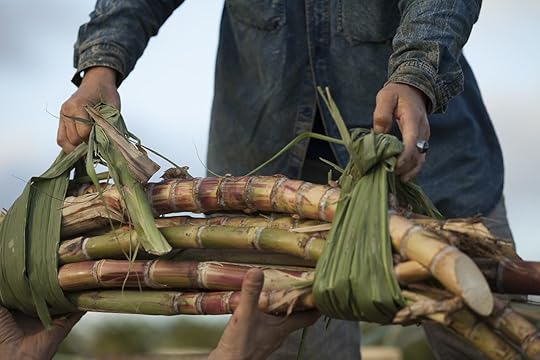
Photo: Kō Hana Distillers
Kō Hana doesn’t burn its sugarcane fields — a practice that burns the leaves off the stalks before harvest, dumping waste into the soil and pouring smoke into the atmosphere — and while the sugarcane itself is harvested exclusively by machete, that might be changing soon. In the aftermath of a series of increasingly hot summers, the distillery is recalibrating the balance between its sustainability goals and the safety of its workers.
“The output of hand-cut cane is putting a strain on our farmers. You have to start thinking about the health of your farmers, too. We have two guys under 25, and I want them to retire with me. I want them to have good lives,” Reutner says.
Harvesting the sugarcane sustainably (and safely) is one part of the equation. Kō Hana also recognizes that treating its ingredients with care simply makes for a higher quality final product. Sure, being environmentally friendly is important, but so is making rum that tastes good.
“It is unlike most rum out there in the world,” Reutner says. “We aren’t trying to eliminate flavor. The goal is to bring out the flavors of the sugarcane. Generally speaking, it’s going to be vegetal, and it’s going to be fruity and tropical with lychee, and banana.”
In order to draw out the complex flavors of the rum, Kō Hana has adopted an adventurous barrel aging program. The distillery has used barrels once home to tequila, peaty scotch, and barley wine.
“All of the good intentions in the world wouldn’t mean anything if we weren’t making something spectacular,” says Reutner.
Good intentions go a long way. In 2019, it is refreshing to encounter a distillery that can see beyond its annual profit. Kō Hana takes advantage of its ability to educate the public not just on the production of rum but also sugarcane’s place in Hawaiian history. The people who walk through the distillery’s doors get much more than a rum tasting.
“They’re going to learn some part of Hawaiin culture that they’re just not going to get at the more saccharine, sweet hotel shops,” Reutner says. “We’re guests to this culture, but we’re sharing stories that will hopefully teach people to be more respectful of the land, and to recognize that this place will be here after they leave too.” 

More like this: How Goslings Rum defines Bermudian culture
The post This rum distillery is helping Hawaii’s heirloom sugarcane thrive once again appeared first on Matador Network.

Uk considers frequent flyer ban

Collectors of frequent flyer miles could soon find themselves with thousands of unusable miles. A report commissioned by the UK government’s climate change advisors calls for miles programs to be eliminated, as they encourage frequent flying and therefore CO2 emissions. An Air Miles Levy was also recommended to tax those who fly frequently without penalizing people who merely take an annual vacation. The report, commissioned by the Committee on Climate Change, is allegedly aimed at the 15 percent of the UK population responsible for taking 70 percent of the flights.
According to the report, “The norm of unlimited flying being acceptable needs to be challenged and as a very high polluting luxury, it is suitable to taxation.” The idea behind the recommendations is that “restrictions to ‘all-you-can-fly’ passes and loyalty schemes which offer air miles would remove incentives to excessive or stimulated flying.”
Such a ban, however, would likely have pretty wide-ranging consequences and result in significant backlash from business and leisure travelers alike.
The UK has committed to reaching net zero carbon emissions by 2050, and this is just the latest report to suggest how to accomplish this. In a separate report by Dr. Richard Carmichael, professor at Imperial College London, domestic intercity rail prices should be dropped to encourage rail travel, and schools should be required to offer plant-based meal options.
Although some experts have supported the idea, the immense popularity of frequent flyer programs makes it extremely unlikely that they will disappear anytime soon. 

More like this: The best travel rewards cards for 2019
The post UK climate change advisors recommend banning frequent flyer programs to reduce emissions appeared first on Matador Network.

Sweetest Day candy holiday history

For the majority of the United States, Halloween is far and away the number one candy holiday in October. The National Retail Federation estimates Americans will spend $2.6 billion on Halloween candy alone in 2019. But long before candy took over the spookiest holiday, the country had a more direct candy-focused day in October: Candy Day, which was later rebranded as Sweetest Day.
The National Confectioners Association started Candy Day in 1916. The reason why was obvious. The NCA wanted Americans to buy more candy, and there was a blank space on the calendar before the holidays in which people had an excuse to give (and, more importantly, buy) sweets. The date was set on the second Saturday in October.
However, a 1916 story in the trade journal Candy and Ice Cream dug up by The Atlantic shows that the NCA didn’t want this to come off as one big marketing ploy.
“The true ‘Candy Day’ spirit is apart from the idea of just stimulating a greater consumption of candy,” the article stated. “This will naturally follow a national educational campaign exploiting the real food value of candy — pure candy. The ‘Spirit of Candy Day’ proper may be interpreted as a spirit of good will, appreciation and good fellowship.”
Sugar rationing during World War I stymied candy production and sales in 1918. With rationing, so went the all-too-young Candy Day. But a pivot came in 1921, this time with an even bigger focus on “a spirit of good will, appreciation and good fellowship.” Candy retailers in cities like Detroit and Cleveland partnered with the Red Cross to give candy to hospitals, orphanages, and the elderly. The name switched from the see-through marketing push of “Candy Day” to the gentler “Sweetest Day.” By 1929, Sweetest Day had officially taken its place on the calendar on the third Saturday in October.

Photo: JeniFoto/Shutterstock
Sweetest Day’s biggest competition came with the rise of Halloween trick or treating. Door-to-door candy asks were mostly limited to Irish and Scottish communities in the early 1900s, and it was called “guising.” Healthier homemade options and toys were common treats. Trick-or-treating didn’t go mainstream in the US until the 1950s.
Pre-packaged candy was a convenient thing to hand out. In the mid-1960s, though, pre-packaged candy became all the more important because of safety concerns. Tales of poisoned candy handed out to trick-or-treaters started coming in, and though they were largely debunked, the alarm bells had already been rung. Sealed, packaged candy was the safest option. Halloween’s candy dominance only went up from there, and today, it’s the biggest candy holiday in the US. And Sweetest Day faded into relative obscurity.
Yet Sweetest Day isn’t entirely lost. Even the earliest Sweetest Day tradition of candy companies buying media advertisements hasn’t ended. This year in Buffalo, New York, Fowler’s Chocolates is promoting the city’s famous sponge candy during Sweetest Day celebrations for what it purports is “a holiday about love” that’s designed “to make one’s community a little brighter by gifting sweet treats to those around you.”
The scope of the Sweetest Day has shrunk since its prime — it seems to primarily be celebrated in the states around the Great Lakes. Still, American culture loves a good “holiday” not tied to religion or specific events. That’s reason enough to eat a couple extra pieces of candy every third Saturday in October. 

More like this: Why Americans obsess over candy corn, according to psychologists
The post How the US tried, and failed, to make a national candy day just before Halloween appeared first on Matador Network.

Restaurants with dog menus

The best steak in South Beach may well be served in a dog bowl.
Ok, maybe not the best steak, but certainly the best steak for the money. Sure, the six-ounce filet mignon comes chopped into little pieces, served atop some bland mashed potatoes, boiled veggies, and has no sauce. But go ahead and find another six-ounce filet for $16. You’ll have better luck finding a parking space.
What is this marvelous dining value in one of America’s most expensive destinations? Well, it’s part of the special dog menu served at Lobster Bar and Sea Grille, a massive steak and seafood emporium with an outdoor patio where you can order up filet mignon and a number of other delicacies for your four-legged friend for a fraction of the human cost.
The dog menu — which also includes a beef short rib stew, meatballs and veggies, chicken chop-chop, and a veggie plate — is full of unseasoned meats and vegetables. They’re kind of devoid of flavor, too, but dogs don’t care. And so is kale, so neither should you.
“This is pretty good,” the older gentleman next to me at the bar said when I offered him some of the beef stew. He seemed initially hesitant to eat what was effectively dog food until the chef told him it was the same short rib they serve to people. “I’d definitely order this.”
“Could I order this?” I asked Lobster Bar’s chef de cuisine Allen Schumann. “Like without a dog?”
“It would be strange,” he answered. “That would be very odd.”
But it wasn’t a hard no.
We treat our dogs better than we treat people, so why not let them eat like us?

Photo: International Smoke
In the era of spoiling dogs to the point that we treat them better than we treat ourselves, restaurants like Lobster Bar have created menus with smaller portions, fewer extra ingredients, and lower prices than they offer to humans.
“What we’re doing is all straight proteins, no additives, with a little rice and veggies,” says Jason Phillips, the general manager of Nose Dive in Greenville, South Carolina. His description of the restaurant’s dog menu is almost verbatim what you might hear from a chef at a trendy “clean eating” establishment. At least until we got to the part where he said his entrees cost $3-8.
Miami and Greenville aren’t the only places serving healthy dog menus. Celebrity chef Michael Mina has gotten into the doggy-menu game, serving up a smoked beef bone and Doggie Moco (ground beef on top of white rice) at his barbecue-themed International Smoke. During brunch at 312 Chicago, your dog can feast on salmon and white rice with veggies for $7 while you down 312’s $22 steak and eggs.
Dogs even get to eat by the water without waterfront prices. Shooters Waterfront on the Intracoastal Waterway in Ft. Lauderdale has a dog menu with something called Bahia Beef, which is made with USDA-certified ground beef, whole wheat macaroni, butternut squash, organic carrots, apples, kale, organic pumpkin seed oil, organic hemp oil, and a blend of essential vitamins and minerals. I could not make up a more spa-menu-sounding entrée in my life, and this one’s only $14.
Even the heartland is in on the action, as Stella in Oklahoma City has a $12 tenderloin and eggs for dogs. I dare you to find a deal like that anywhere outside a buffet in Winnemucca.
Dog menus are for room service, too.

Photo: Hotel Nia, Autograph Collection/Facebook
It’s not just restaurants catering chef-quality meals for your dog. You can also take advantage of these magnificent canine menus at a bunch of hotels across America, where there’s the added bonus of having the dog meals brought to your room like regular room service.
“We wanted to stay as close to the Northern California ethos of farming as we could, all-organic if possible,” says Julie Ramey, the director of sales and marketing the Hotel Nia in Silicon Valley, when describing the hotel’s in-room dog menu. Nia’s canine offerings include Glaum Ranch eggs with quinoa, cheddar cheese, and kale. Another option is Pitman Farms chicken with potatoes and broccolini. Those will run you $10 each.
A little farther south, the Fairmont Miramar in Santa Monica brings gourmet room service to dogs as part of its “Dog be With You” package. Matador‘s managing editor went there a while ago with her dog to try it out, and the pictures prove the experience was five stars all around, for everyone except the cleaning crew, probably.
At the Hilton Sedona at Bell Rock, after your dog is done getting its aura reading (this is an actual option in Sedona) it can get a burger topped with peanut butter and baked fries for $6.25. Or bacon and eggs for $5.75.
Am I seriously suggesting we all start showing up and ordering off the dog menu? No. (Maybe.) But these restaurant offerings are definitely a delicious way to spoil your dog while also ensuring they’re getting the same healthy nutrients you’d eat yourself. And if you steal a bite of steak off your dog’s plate out of curiosity, we certainly wouldn’t judge. 

More like this: This luxe Santa Monica hotel will send gourmet room service to your dog
The post Restaurants around the country are offering dog menus just as good as human menus appeared first on Matador Network.

Jim Beam distillery renting Airbnb

If you’re looking for a nice little countryside retreat where you can detox and avoid the temptation of alcohol, this Jim Beam distillery Airbnb probably isn’t for you. Jim Beam Bourbon just announced its first-ever property listing on Airbnb, renting out the Jim Beam American Stillhouse in Clermont, Kentucky, to guests.
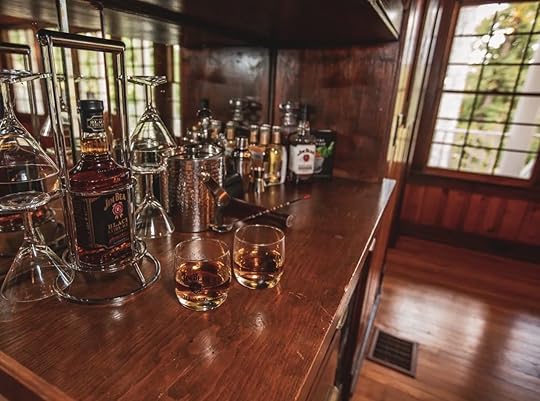
Photo: Airbnb
According to the press release, visitors will be able to “live, eat and even sleep like the seven generations of Master Distillers, in a historic and charming Kentucky house overlooking nearby Everbach Lake on the distillery grounds.” In addition to a distillery tour, guests can also look forward to a bourbon tasting, classic BBQ meals, and an inside look at how the popular bourbon is created.

Photo: Airbnb
Guests will be staying in a rustic house built in 1919, with three bedrooms and two and a half bathrooms. The house is equipped with a fireplace, fully stocked bourbon bar, backyard, and fishing docks.
Fred Noe, Jim Beam’s seventh-generation Master Distiller, said, “We like to say that anyone who visits us comes as friends and leaves as family, so we’re thrilled to welcome our extended family for some bourbon and Kentucky hospitality.”
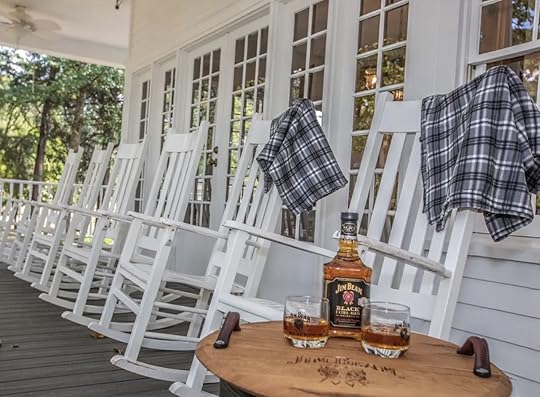
Photo: Airbnb
Prospective guests can request a one night stay on the grounds via Airbnb, valid for a limited number of dates through the end of 2019. The best part is that stays only cost $23 — the same price of a bottle of Jim Beam Black bourbon. Reservations are first-come, first-served, so if you’re over 21 and interested, you should book fast. 

More like this: 9 Irish whiskeys to drink that aren’t Jameson
The post You can now stay overnight at the Jim Beam distillery on Airbnb appeared first on Matador Network.

Matador Network's Blog
- Matador Network's profile
- 6 followers



